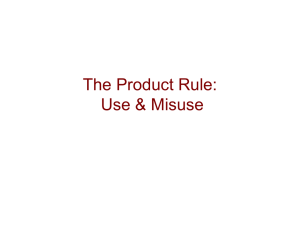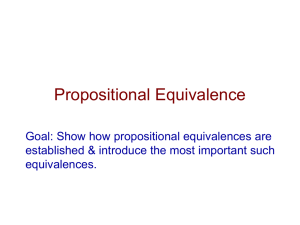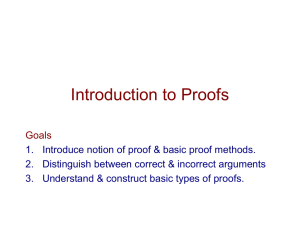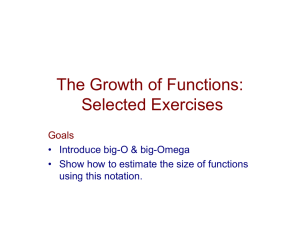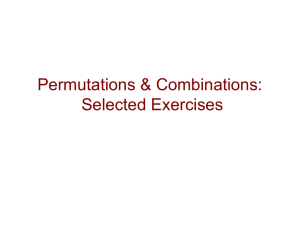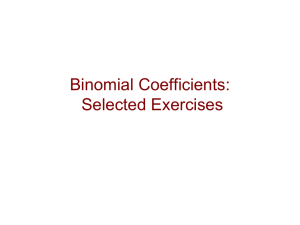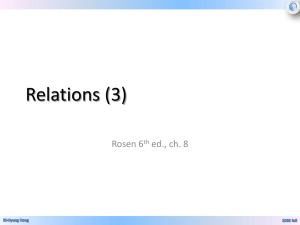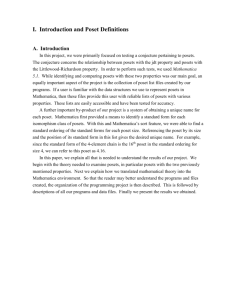Partial Orderings
advertisement
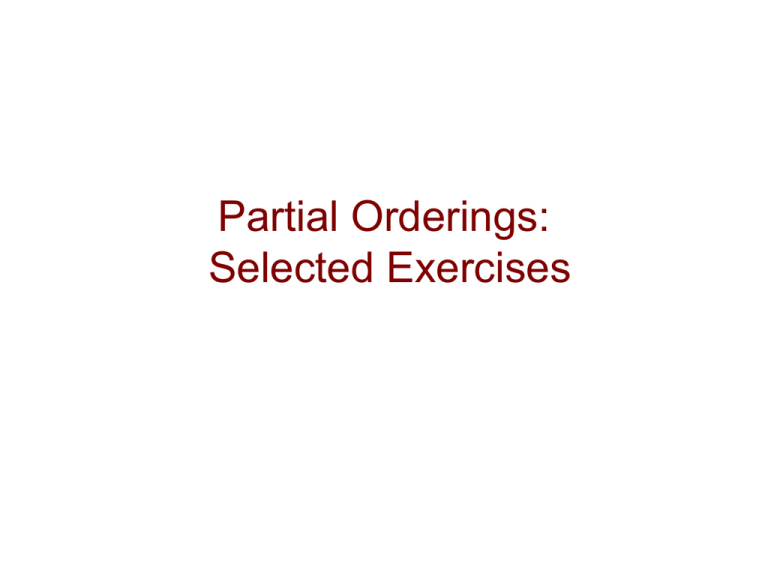
Partial Orderings:
Selected Exercises
Partial Order
• Let R be a relation on A.
• R is a partial order when it is:
– Reflexive
– Antisymmetric
– Transitive.
Copyright © Peter Cappello
2
Exercise 10
a
b
c
d
Is this directed graph a partial order?
Copyright © Peter Cappello
3
Exercise 10 Solution
a
b
c
d
Is this directed graph a partial order?
Is it reflexive?
Is it antisymmetric?
Is it transitive?
Copyright © Peter Cappello
4
Exercise 20
Draw the Hasse diagram for the “≥” relation on
{ 0, 1, 2, 3, 4, 5 }.
Copyright © Peter Cappello
5
Exercise 20 Solution
Draw the Hasse diagram for the “≥” relation on
{ 0, 1, 2, 3, 4, 5 }.
In a Hasse diagram:
1.
1
Direction is implied (up), hence omitted
I.e., we use edges instead of arcs.
2.
0
Edges implied by transitivity are omitted
2
3
4
5
Copyright © Peter Cappello
6
Exercise 40
a) Show that there is exactly 1 greatest element of a poset, if
such an element exists.
Copyright © Peter Cappello
7
Exercise 40
a) There is exactly 1 greatest element of a poset, if such an
element exists.
Proof:
a) By contradiction: Assume x & y are distinct greatest elements.
b) x y
(Step a: y is a greatest element)
c) y x
(Step a: x is a greatest element)
d) x = y.
(Step b & c & antisymmetry)
Copyright © Peter Cappello
8
Exercise 40 continued
b) Show that there is exactly 1 least element, if such an
element exists.
Proof: Similar to part a)
Copyright © Peter Cappello
9
•
Let S be a set with n elements.
•
Consider the poset ( P( S ), ).
•
What does the Hasse diagram look like when:
1. Let |S| = 0
2. Let |S| = 1
3. Let |S| = 2
4. Let |S| = 3
5. Let |S| = 4
6. Let |S| = n
Copyright © Peter Cappello
10
|S| = 0; | P( S ) | = 20
Hasse diagram: a 0-cube: Just a single point.
Ø
Copyright © Peter Cappello
11
|S| = 1; | P( S ) | = 21
Represent each subset by a 1-bit string:
0 represents the empty set
1 represents the set with 1 element.
Hasse diagram: a 1-cube: Just a single edge.
1
0
Copyright © Peter Cappello
12
|S| = 2; | P( S ) | = 22
Represent each subset by a 2-bit string: b1 b2
Hasse diagram: a 2-cube: Just a square.
11
10
01
00
Copyright © Peter Cappello
13
|S| = 3; | P( S ) | = 23
Represent each subset by a 3-bit string: b1 b2 b3
Hasse diagram: a 3-cube.
111
110
101
011
100
010
001
000
Copyright © Peter Cappello
14
|S| = 4; | P( S ) | = 24
Represent each subset by a 4-bit string: b1 b2 b3 b4
Hasse diagram: a 4-cube.
Copyright © Peter Cappello
15
1111
1101
1110
1100
1000
1010
1011
1001
0111
0101
0110
0100
0011
0001
0010
Copyright © Peter
0000Cappello 2011
16
1111
1101
1110
1100
1000
1010
1011
1001
0101
0110
0100
Sub-diagram
For elements 1, 2, 3
0111
0011
0001
0010
Copyright © Peter
0000Cappello 2011
17
1111
1101
1110
1100
1000
1010
1011
1001
0101
0110
0100
Sub-diagram
For elements 2, 3, 4
0111
0011
0001
0010
Copyright © Peter
0000Cappello 2011
18
1111
1101
1110
1100
1000
1010
1011
1001
0101
0110
0100
Sub-diagram
For elements 1, 2, 4
0111
0011
0001
0010
Copyright © Peter
0000Cappello 2011
19
In the Connection Machine, 216 processors were
connected as a 16-cube.
Copyright © Peter Cappello
20
Topological Sorting
• Total ordering T is compatible with partial
ordering P when a, b ( a ≤P b a ≤T b ).
• Element a is minimal when there is no
element b with b ≤ a.
Copyright © Peter Cappello
21
Topological Sorting
• Problem (Topological Sort)
– Input: A finite partial ordering ( S, ≤ ).
– Output: A compatible total ordering.
– Algorithm:
While ( S ≠ )
output ( S.removeAMinimalElement() );
• What are good data structures for
finding a minimal element?
Copyright © Peter Cappello
22
End 8.6
Copyright © Peter Cappello
23
Exercise 30
Let ( S, ) be a poset, and let x, y S.
Notation: x < y means x y and x ≠ y.
Definitions:
• y covers x if x < y and z S ( x < z < y ).
• The covering relation of (S, ) = { ( x, y ) | y covers x }.
Show:
( x, y ) is in the covering relation of finite poset ( S, )
x is lower than y and an edge joins x & y in the Hasse diagram.
A poset’s covering relation defines the edge set of its Hasse diagram.
Copyright © Peter Cappello
24
Exercise 30 Solution
x is lower than y and an edge joins x & y in the Hasse diagram
(x, y) is in the covering relation of finite poset (S, ).
Proof:
1.
Assume x is lower than y and an edge joins x & y in the Hasse
diagram.
2.
x < y.
(Defn. of Hasse diagrams)
3.
(An edge joins x to y) z S ( x < z < y ).
(Defn. of Hasse
diagrams)
4.
An edge joins x to y.
(Step 1)
5.
z S ( x < z < y ).
(Step 3 & 4 & modus ponens)
6.
Therefore, x is covered by y. (Step 2 & 5, defn. of covers)
Copyright © Peter Cappello
25
Exercise 30 Solution
( x, y ) is in the covering relation of finite poset ( S, )
x is lower than y and an edge joins x & y in the Hasse diagram.
Proof:
1.
Assume ( x, y ) is in the covering relation of finite poset ( S, ).
2.
x<y
3.
x is lower than y in diagram. (Step 2 & Defn. of Hasse diagram)
4.
z ( x < z < y ).
5.
An edge joins x to y.
(Defn of y covers x)
(Defn. of y covers x)
(Step 2 & 4 & Defn. of Hasse diagram)
Copyright © Peter Cappello
26
50
Defn. If (S, ) is a poset & every 2 elements are
comparable, S is totally ordered.
Defn. x is the least upper bound of A if x is an upper bound
that is less than every other upper bound of A.
Defn. x is the greatest lower bound of A if x is a lower bound
that is greater than every other lower bound of A.
Defn. A poset in which every 2 elements have a least upper
bound & a greatest lower bound is a lattice.
Show that every totally ordered set is a lattice.
Copyright © Peter Cappello
27
50 continued
Prove S is totally ordered S is a lattice.
Proof
1. Assume S is totally ordered.
2. a, b (a b b a).
(Defn. of total order)
3. Select 2 arbitrary elements a, b S.
4. Assume without loss of generality a b.
5. a is the greatest lower bound of {a, b}.
(Step 3)
6. b is the least upper bound of {a, b}.
(Step 3)
7. S is a lattice.
(Step 4 & 5, Defn. of lattice)
Copyright © Peter Cappello
28
60
Defn. a is maximal in poset (S, ) if b S ( a < b ).
Show:
Poset (S, ) is finite & nonempty a S, a is maximal.
Proof:
1. Assume poset (S, ) is finite & nonempty.
2. Let a S.
(Step 1: S )
3. for ( max := a; S ; S := S – {b} )
1. Let b S.
2. If max < b, max := b.
4. max is maximal.
5. Step 3 terminates. (S is finite; smaller each iteration)
Copyright © Peter Cappello
29
